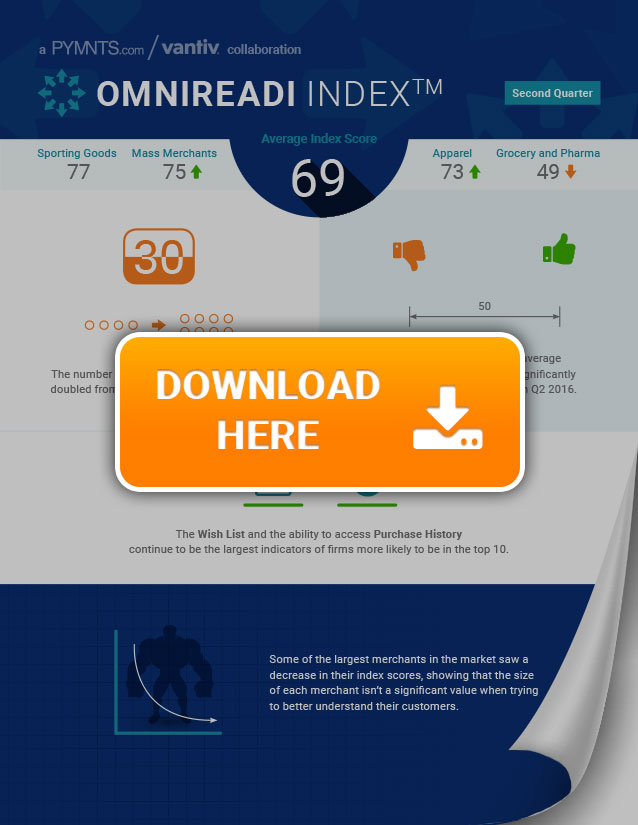There’s an enormous chasm between the businesses with the best and worst omnichannel strategies and executions. And the gap continues to widen.
In the Q4 2015 Index, we reported that sporting goods had omnichannel the most together of any vertical, leading the way with the highest score in the Index, while Grocery/Pharma finished with the worst score. That hasn’t changed.
In fact, the least omnireadi companies have fallen further behind. Scores for most merchants increased from Q2 2015 to Q4 2015 before stagnating in Q1 2016. Meanwhile, scores for the bottom 10 percent of companies rose briefly during Q2 2015 before plummeting by nearly 20 percent between Q3 2015 and Q1 2016.
The Index is based on two key components: whether a merchant adds value through a mobile app or website, and how consistent online and in-store experiences are for consumers. The goal is to measure how well merchants are providing a consistent, frictionless experience that allows consumers to browse their sites whenever and however they choose. Additionally, the Index reveals how individual omnichannel merchant’s user experiences stack up across the board.
Key takeaways from the OmniReadi Index for the Q2 2016 include:
Advertisement: Scroll to Continue
- Omnireadiness on average did not increase in the first quarter of 2016. Our results from April 2016 are remarkably close to the December 2015 findings, with one major distinction: scores for the lowest tier of companies continue to spiral downward.
- What’s driving that decrease in omnireadiness? A combination of factors, including purchase history, wish lists, price matching and quick checkout features.
- Size doesn’t matter — despite their resource advantage, big companies did not fare any better than smaller ones in this edition of the Index. In fact, the biggest growth in average index score between June 2015 and December 2015 comes from companies with less than $1 billion in revenue, while companies with more than $20 billion in revenue failed to match the average improvement of all firms combined.
The PYMNTS.com OmniReadi Index™, powered by Vantiv, was designed to quantify the consistency between the web and in-store shopping experience and determine if the mobile channel is helping, hurting or simply neutral to the overall situation.
The Index includes in-depth research on more than 100 retailers across the U.S. We researched a breadth of merchants in the Top 500 based on total U.S. revenue in the following merchant segments: Home Furnishings and Office Supplies, Specialty Stores, Home Improvement, Electronics and Entertainment, Grocery and Pharma, and Hardware.
To compile the index, researchers in Boston; Chicago; Charlottesville, Virginia; and Seattle shopped merchants across three channels: web, app, and in-store.
We utilized regression analysis to narrow the list of all attributes captured to 17 factors which truly affect a customer’s ability to have a consistent shopping experience across multiple channels. The scores of the Index range from 0-100, with 0 referring to the worst omnireadi capability and 100 referring to the ultimate omnireadiness of a merchant.
The growth of the omnichannel store-to-door ecosystem
One of the conveniences afforded by the rise of smartphones is the development of on-demand sharing services. Among these are a number of well-known “store-to-door” delivery companies, like Seamless and Favor, which operate independently of merchants and act as intermediaries between in-home consumers and merchants. And, depending on the company, they will deliver almost anything, from groceries and dry cleaning to dinner and drinks.
Since bursting on to the scene and widening delivery options for diners and couch potatoes everywhere, the services have gained some serious traction, even taking a bite out of pizza’s delivery dominance.
To discuss the digital delivery space and its role in helping to bring restaurants into the omnichannel ecosystem, PYMNTS recently caught up with Keith Duncan, Senior Vice President of Sales and Business Development for Favor, a store-to-door service that launched in 2013.
Here’s a sneak peek:
According to Duncan, restaurants that continue to trail behind the omnicommerce movement will face difficulties in an integrated world.
“They need to embrace the shift in consumer behavior enabled by mobile and the expectations the on-demand economy have created. [Favor’s] ultimate goal is to show how you can reach new customers and incremental sales without cannibalizing their existing business or causing more work,” he said. “If anything, embracing omnichannel should help increase margins and make their business more pro table. Restaurateurs are passionate about their food and their business. We want to enable them to focus on that.”
The main obstacles preventing them from evolving into omnichannel merchants? Cost of implementation (63 percent), lack of infrastructure (50 percent), service and repair (49 percent), per transaction costs (49 percent), customer acceptance (48 percent) and staff training (44 percent).
Duncan explained that omnichannel delivery apps like Favor are helping eateries offer consumers a cutting-edge service unmitigated by these issues.
“Most local restaurants and merchants do not have the resources or time to offer comprehensive Store-to-Door solutions so we try to do the heavy lifting for them and provide a delivery option without the headaches or upfront costs,” he said. “We bring both the audience and the workforce. We also offer a solution and process that this is frictionless to their day-to-day operations so our orders are seamless and no different than any other customer.”
To download the 2016 Q2 PYMNTS.com Omnireadi Index™, powered by Vantiv, click below.

About the Index
The PYMNTS.com OmniReadi Index™, powered by Vantiv, provides a quarterly data-driven critique of how effectively merchants are meeting consumers’ needs across online, in-store and mobile.





